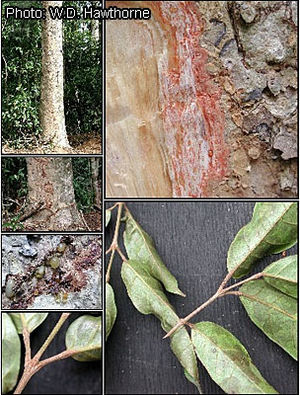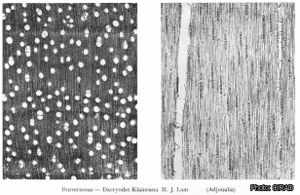Dacryodes klaineana (PROTA)
Introduction |
| General importance | |
| Geographic coverage Africa | |
| Geographic coverage World | |
| Fruit | |
| Medicinal | |
| Timber | |
| Fuel | |
| Fibre | |
| Food security | |
| Conservation status | |
Dacryodes klaineana (Pierre) H.J.Lam
- Protologue: Bull. Jard. Bot. Buitenzorg, ser. 3, 12: 336 (1932).
- Family: Burseraceae
Synonyms
- Pachylobus deliciosus (A.Chev. ex Hutch. & Dalziel) Pellegr. (1934).
Vernacular names
- Monkey plum, African cherry fruit (En).
Origin and geographic distribution
Dacryodes klaineana is distributed in forest regions from Sierra Leone to Gabon.
Uses
The wood (trade name: adjouaba) is used in construction and for mortars, axe handles and wagons. It has also been recommended for telegraph poles and railway sleepers. It is considered suitable for interior joinery, furniture and parquetry. It is also used as fuelwood and has been used for paper making.
The fruit is eaten raw or cooked; the pulp is boiled or roasted to yield a kind of butter. The ground leaf is an ingredient of an enema applied against painful menstruation. In Côte d’Ivoire Dacryodes klaineana is used to treat tachycardia and cough.
Properties
The heartwood is grey to yellowish grey-brown with darker streaks, giving it a decorative appearance; the sapwood is whitish grey and wide, up to more than 10 cm. The wood contains silica. It is rather heavy, with a density of 730–940 kg/m³ at 12% moisture content. The wood dries quite fast and well. The rates of shrinkage from green to oven dry are 6.4–8.0% radial and 8.3–10.3% tangential. The wood is hard. At 12% moisture content, the modulus of rupture is 111–229 N/mm², modulus of elasticity 12,900–18,700 N/mm², compression parallel to grain 55–78 N/mm², shear c. 18 N/mm², cleavage 18–28 N/mm and Chalais-Meudon side hardness 5.8–7.9. The wood is moderately difficult to work. The heartwood is resistant to impregnation with preservatives.
The leaves contain tannins and traces of saponins.
Description
- Dioecious, evergreen, medium-sized tree up 25(–30) m tall; bole branchless for up to 10 m, up to 60(–120) cm in diameter, lower part usually straight and slightly angular, higher part often twisted, base with low root swellings or root spurs rarely higher than 60 cm; outer bark grey-greenish or blackish, very scaly, with irregular scales leaving yellowish marks after shedding, inner bark pink-brown or red-brown, with turpentine smell, exuding a watery or gummy liquid when cut; crown rounded, dense.
- Leaves alternate, imparipinnately compound with (2–)3(–4) pairs of leaflets, 15–30 cm long, rusty hairy when young, glabrescent but with persistent hairs on petiole, rachis and midvein; stipules absent; petiole 2.5–6.5 cm long, rachis 2–8 cm long; lateral petiolules (2–)8–14 mm long, terminal one 10–22 mm long, jointed at the top; leaflets opposite, elliptical to ovate, 4.5–18.5 cm × (1.5–)2–6.5 cm, base usually asymmetric, apex acuminate, pinnately veined with 6–12 pairs of lateral veins, markedly looped.
- Inflorescence a terminal or sometimes axillary panicle 10–22(–30) cm long, densely rusty hairy, with flowers in fascicles.
- Flowers unisexual, regular, pale creamy; pedicel 2–4 mm long; sepals 3, broadly ovate, c. 2 mm long, densely hairy outside, glabrous inside; petals 3, ovate, c. 4 mm long, densely hairy outside, papillate inside; male flowers with 6 stamens, filaments c. 1.5 mm long, ovary much reduced; female flowers with superior, hairy ovary and reduced stamens.
- Fruit an ovoid drupe c. 2 cm × 1.5 cm, slightly laterally flattened, slightly pointed at top, orange when ripe, with fleshy, fragrant pulp, stone ellipsoid, c. 2 cm × 1 cm, 1-seeded.
- Seedling with epigeal germination.
Other botanical information
Dacryodes klaineana grows slowly. In the evergreen forest of Irobo (Côte d’Ivoire), the average annual diameter growth is 1.2 mm under natural conditions, and 2.6–3.1 mm in partially thinned locations. Dacryodes klaineana flowers at the beginning of the dry season, October–November in Liberia, where the fruits are ripe in January–February. Natural regeneration by seedlings is abundant.
Dacryodes comprises about 40 species, occurring in the American, Asian and African tropics. In Africa, about 20 species have been found, all of section Pachylobus. Gabon seems richest with approximately 10 species.
Ecology
Dacryodes klaineana mostly occurs in the understorey of evergreen, deciduous or riverine forest, sometimes in higher layers of the canopy. It is widespread and locally abundant.
Management
The 1000-seed weight is about 1.3 kg. Seeds take 15–30 days to germinate. Young seedlings in the nursery should be shaded. Dacryodes klaineana is not planted in Côte d’Ivoire, but trees are retained and protected during clearing for agricultural purposes. Marketable logs are mostly defective, with very large ones often being hollow.
Genetic resources
In view of its wide distribution and local abundance, Dacryodes klaineana does not seem much threatened, but in Côte d’Ivoire and Cameroon it is considered vulnerable.
Prospects
The quality of the wood of Dacryodes klaineana is much lower than that of ozigo (Dacryodes buettneri (Engl.) H.J.Lam), due to the logs often being defective, the smaller diameter and the wide sapwood. Therefore, its prospects as a timber tree of commercial importance seem limited.
Major references
- Aubréville, A., 1962. Burséracées. Flore du Gabon. Volume 3. Muséum National d’Histoire Naturelle, Paris, France. pp. 53–95.
- Burkill, H.M., 1985. The useful plants of West Tropical Africa. 2nd Edition. Volume 1, Families A–D. Royal Botanic Gardens, Kew, Richmond, United Kingdom. 960 pp.
- Dudek, S., Förster, B. & Klissenbauer, K., 1981. Lesser known Liberian timber species. Description of physical and mechanical properties, natural durability, treatability, workability and suggested uses. GTZ, Eschborn, Germany. 168 pp.
- Takahashi, A., 1978. Compilation of data on the mechanical properties of foreign woods (part 3) Africa. Shimane University, Matsue, Japan, 248 pp.
- Voorhoeve, A.G., 1979. Liberian high forest trees. A systematic botanical study of the 75 most important or frequent high forest trees, with reference to numerous related species. Agricultural Research Reports 652, 2nd Impression. Centre for Agricultural Publishing and Documentation, Wageningen, Netherlands. 416 pp.
Other references
- Adjanohoun, E.J. & Aké Assi, L., 1979. Contribution au recensement des plantes médicinales de Côte d’Ivoire. Centre National de Floristique, Abidjan, Côte d’Ivoire. 358 pp.
- Aubréville, A., 1959. La flore forestière de la Côte d’Ivoire. Deuxième édition révisée. Tome deuxième. Publication No 15. Centre Technique Forestier Tropical, Nogent-sur-Marne, France. 341 pp.
- de la Mensbruge, G., 1966. La germination et les plantules des essences arborées de la forêt dense humide de la Côte d’Ivoire. Centre Technique Forestier Tropical, Nogent-sur-Marne, France. 389 pp.
- Durrieu de Madron, L., Favrichon, V., Dupuy, B., Bar-Hen, A. & Maître, H.-F., 1998. Croissance et productivité en forêt dense humide: bilan des expérimentations dans le dispositif d’Irobo, Côte d’Ivoire (1978–1990). Document Forafri 2. Cirad, Montpellier, France. 69 pp.
- Firmin, A., 1999. Changes in African cherry fruit (Dacryodes klaineana) during postharvest ripening. Tropical Science 39(1): 16–17.
- Kryn, J.M. & Fobes, E.W., 1959. The woods of Liberia. Report 2159. USDA Forest Service, Forest Products Laboratory, Madison, Wisconsin, United States. 147 pp.
- Neuwinger, H.D., 2000. African traditional medicine: a dictionary of plant use and applications. Medpharm Scientific, Stuttgart, Germany. 589 pp.
- Normand, D., 1955. Atlas des bois de la Côte d’Ivoire. Tome 2. Centre Technique Forestier Tropical, Nogent-sur-Marne, France. 132 pp.
- Stoker, D.L., Winandy, J.E. & Achi, E.K., 1996. Engineering properties of two underutilised Côte d’Ivoire species: adjouaba and aniouketi. Journal of Tropical Forest Products 2(1): 114–124.
- Vivien, J. & Faure, J.J., 1988. Fruitiers sauvages du Cameroun. Fruits Paris 43(9): 507–516.
Author(s)
- M. Brink, PROTA Network Office Europe, Wageningen University, P.O. Box 341, 6700 AH Wageningen, Netherlands
Correct citation of this article
Brink, M., 2008. Dacryodes klaineana (Pierre) H.J.Lam. In: Louppe, D., Oteng-Amoako, A.A. & Brink, M. (Editors). PROTA (Plant Resources of Tropical Africa / Ressources végétales de l’Afrique tropicale), Wageningen, Netherlands. Accessed 22 December 2024.
- See the Prota4U database.


